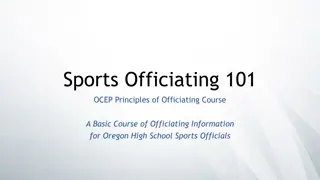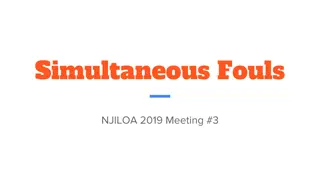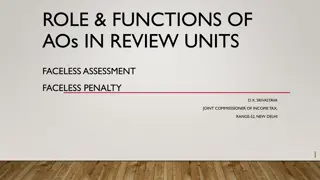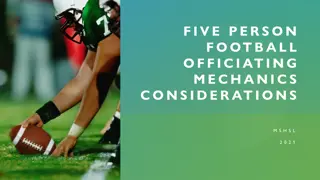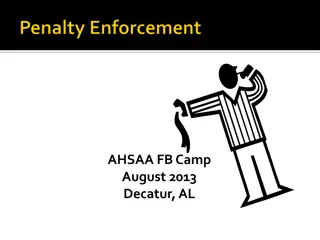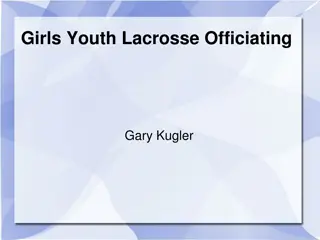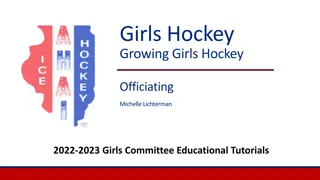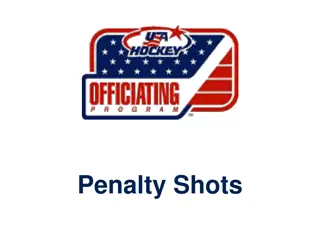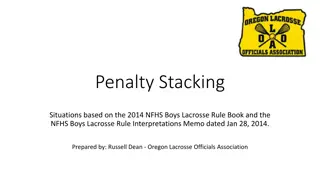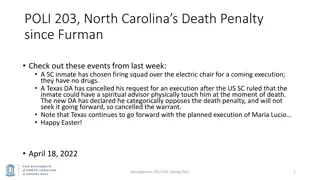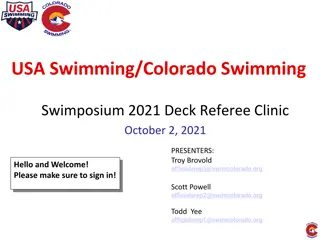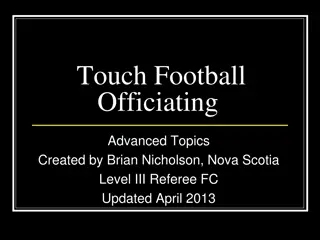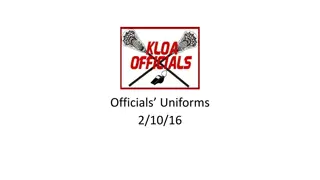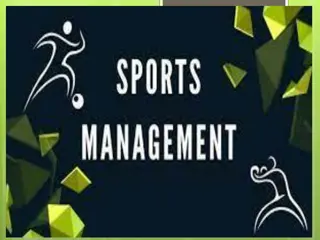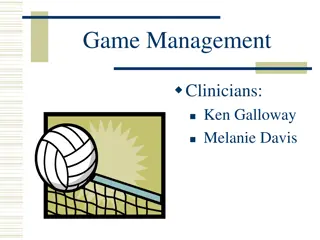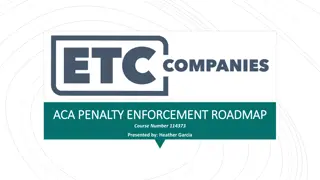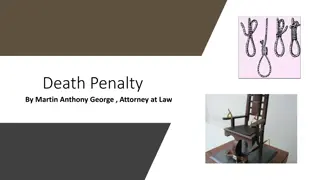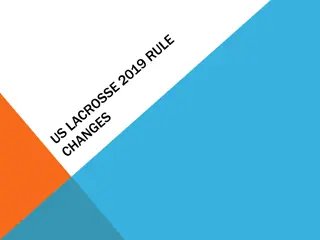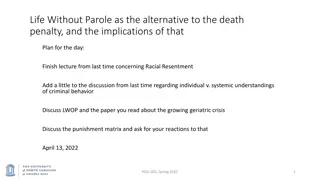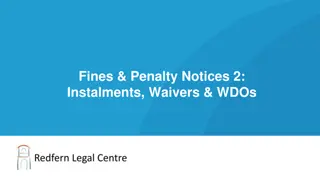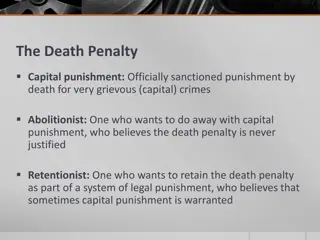Efficient Penalty Enforcement Techniques in Sports Officiating
Learn how to effectively enforce penalties in sports officiating by creating consistency, maintaining professionalism, and following specific guidelines to save time and energy while minimizing confusion. Improve your officiating crew's confidence, reduce criticism, and ensure a smooth flow of the game with detailed insights and practical tips.
Download Presentation

Please find below an Image/Link to download the presentation.
The content on the website is provided AS IS for your information and personal use only. It may not be sold, licensed, or shared on other websites without obtaining consent from the author. Download presentation by click this link. If you encounter any issues during the download, it is possible that the publisher has removed the file from their server.
E N D
Presentation Transcript
Efficient Penalty Enforcement Techniques
Efficient Penalty Enforcement Techniques 1. Goals 2. Expected Results 3. Calling Official s Requirements 4. Other Officials Duties by Position 5. General Commentary 6. Other Tips about Penalty Enforcement
Efficient Penalty Enforcement Techniques 1. Goals Create consistency in our mechanics. Be as efficient as possible. Promote confidence and eliminate the appearance of confusion by moving smartly and with purpose while specifically avoiding the appearance of wandering around.
Efficient Penalty Enforcement Techniques 2. Expected Results Move the game along at a more professional pace. Appear more confident as a crew. Draw less criticism. Reduce game time. Save steps/energy.
Efficient Penalty Enforcement Techniques 3. Calling Official s Requirements Stop the clock. If a live-ball foul, sound a whistle so that everyone else is alerted to the fact that a foul call has been made. Get the offending player s number. If multiple flags in the same area: a. Get together with other calling official(s) and make a determination as to what will be reported. b. If one foul, make a decision quickly and only one official reports the foul to the Referee. c. If multiple fouls, all calling officials report their fouls to the Referee.
Efficient Penalty Enforcement Techniques Report foul(s) to the Referee a. Fouls prior to the snap: i. Calling official will meet the Referee at the in the offensive backfield to report the foul. Note: On Dead Ball Fouls with one official making the call: Wing Official False Start, Encroachment & Illegal Substitution or Back Judge Delay-of-Game the calling official may give the prescribed signal for the type of foul to the Referee as he is moving to report the number of the offending player.
Efficient Penalty Enforcement Techniques b. Live ball or post-play fouls: i. If the end of the play is more than fifteen yards downfield, meet the Referee: a. at the spot of the flag, or b. half way as he (the Referee) is advancing downfield. ii. If the end of the play is less than fifteen yards downfield or the succeeding spot would otherwise be the previous spot, meet the Referee: a. at the previous spot, or b. the spot of the flag.
Efficient Penalty Enforcement Techniques c. Report clearly, concisely, completely, and calmly the: i. Result of the play (catch/no catch, turnover, first down, etc.). ii. The type of play from an enforcement point-of-view: Loose ball, Running or Post-Scrimmage Kick (PSK). iii. The type of foul (Holding, Personal Foul, Pass Interference, etc.). iv. The offending team. v. The offending player s number.
Efficient Penalty Enforcement Techniques Reporting Examples: I have Defensive Pass Interference on #38 the pass was incomplete. I have Holding on the Offense # 75 the foul was on the 45 at the Spot of the flag. After the play - I have a Dead Ball Personal Foul on #45 of the Offense for a late hit. The result of the play is a 1st down and the ball carrier went OOB. During the Play I have a Personal foul on #78 of the Defense there was a touchdown on the play by the Offense Note: Never forget about Clock Status and where the play ended (Spot) Be prepared to discuss enforcement and team options. Complete any other duties specific to your position.
Referee Duties 4. Other Officials Duties by Position Referee a. Gather information. b. Give preliminary signal to teams bench with choice, if needed. See Notes Below c. Step out of player traffic and make yourself easily visible to press box to give signals (1-2 steps maximum). Stand completely stationary and face the press box when making all penalty signals.
Referee Duties o Jog Away o If you have Microphone speak clearly Numbers if approved Less is more Example False Start Offense 5 Yard Penalty 2nd down Example After the Play (while giving the DB Signal) Personal Foul Defense 15 yard penalty 1st down Use After the Play instead of Dead Ball Do not try to explain penalties like PSK use by rule the Penalty will be from o Pre-snap Foul No reason to give Dead Ball Signal everyone knows the Ball was Dead
Referee Duties d. If obvious, make decisions for a team. e. Tell the Umpire what will be enforced: who should know enforcement i. The enforcement spot. ii. Direction in which to mark off penalty. iii. The distance portion of the penalty iv. The destination yard line if limited to half the distance to the goal.
Referee Duties f. Move with purpose by walking briskly and/or jogging to position. Do not run around as it gives the appearance of confusion and/or indecision. g. Post enforcement: i. Make sure all officials and the chains are in position. ii. Mark the ball ready for play without undue delay. iii. Don t rush the ready for play if players seem confused or disorganized as a result of penalty administration.
Umpire Duties a. Find out what the flag is for as soon as possible. b. Become an expert in penalty administration and be an aid to the Referee throughout the enforcement process. c. If a team decision is needed, find a team captain. d. Get the football
Umpire Duties e. Listen to the Referee s instructions (again, be an aid .don t let the Referee make a mistake). f. Walk off the distance, and put the ball down quickly and purposefully. g. Check the distance with your wing officials. h. Assist the Referee with clock status.
Head Linesman a. Communicate with the head coach the foul and anything unusual such as a loss of down or status of the clock if near the end of a half. b. Cover flags, as needed, if Back Judge on your side is calling official. c. Walk the penalty off with the Umpire. d. You are the primary confirmation on penalty administration.
Line Judge a. Communicate with the head coach the foul and anything unusual such as a loss of down or status of the clock if near the end of a half. b. You are the secondary confirmation on penalty administration. c. Cover flags, as needed, if Back Judge is the calling official. d. Assist the Referee by signaling resulting down and the clock status.
Back Judge a. Communicate the status of the ball and the result of the play. Be prepared to hold the spot until an enforcement choice is made. b. You are primarily responsible for covering flags as the calling official reports the foul(s) to the Referee. All flags should be covered even if it means covering a flag on the opposite side of the field. Exceptions: Dead ball fouls called by wing officials do NOT need to be covered by the Back Judge. Similarly, delay-of-game calls by the Back Judge do NOT require coverage by any other official. c. You are responsible for clock status. d. You are the third party for confirmation on penalty administration.
General Commentary There are too many scenarios to specifically address exactly where to conduct the report foul discussion between the calling official and the Referee. Common sense should prevail. Once the Referee is aware that a foul has occurred, he should proactively move toward the calling official to expedite the enforcement process. Likewise, the calling official should make every effort to meet the Referee at the most efficient spot, which could be the previous spot. Remember, the mechanic also requires the Umpire to be a second set of ears in deciphering information from the calling official and determining enforcement options. With that in mind, it makes sense for the Linesman and Back Judge to make every effort to return to an area that is most convenient for both Referee and Umpire to participate
Other Tips about Penalty Enforcement Most pre-snap fouls will require very little discussion. The Referee should pick up the player number in most Everyone on the crew should know, understand and be able to explain penalty administration to the coaches. Free Kick Fouls: Officials should get the decision from the sideline coach ASAP. Communicate clock status to the Referee and the entire crew.


